ARCO is a brand of gasoline stations currently owned by Marathon Petroleum after BP sold its rights. BP commercializes the brand in Northern California, Oregon and Washington, while Marathon has rights for the rest of the United States and Mexico.

The Toronto Stock Exchange is a stock exchange located in Toronto, Ontario, Canada. It is the 10th largest exchange in the world and the third largest in North America based on market capitalization. Based in the EY Tower in Toronto's Financial District, the TSX is a wholly owned subsidiary of the TMX Group for the trading of senior equities.

Philadelphia Stock Exchange (PHLX), now known as Nasdaq PHLX, is the first stock exchange established in the United States and the oldest stock exchange in the nation. The exchange is owned by Nasdaq, which acquired it in 2007 for $652 million, and is headquartered in Philadelphia.
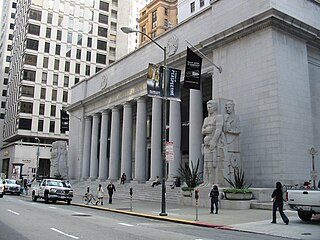
The Pacific Exchange was a regional stock exchange in California, from 1956 to 2006. Its main exchange floor and building were in San Francisco, California, with a branch building in Los Angeles, California.
Sumitomo Corporation is one of the largest worldwide sogo shosha general trading companies, and is a diversified corporation. The company was incorporated in 1919 and is a member company of the Sumitomo Group.

San Pedro Bay is an inlet on the Pacific Ocean coast of southern California, United States. It is the site of the Port of Los Angeles and the Port of Long Beach, which together form the fifth-busiest port facility in the world and the busiest in the Americas. The Los Angeles community of San Pedro borders a small portion of the western side of the bay, and shares the name. The city of Long Beach borders the port on the eastern side of the bay. The northern part of the bay, which is the largest part of the port, is bordered by the Los Angeles neighborhood of Wilmington.
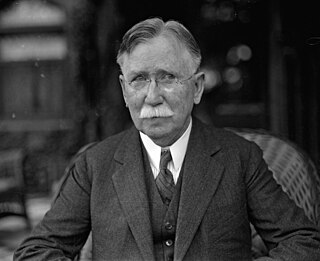
Edward Laurence Doheny was an American oil tycoon who, in 1892, drilled the first successful oil well in the Los Angeles City Oil Field. His success set off a petroleum boom in Southern California, and made him a fortune when, in 1902, he sold his properties.

George Edwin Bergstrom was an American architect who designed The Pentagon in Arlington County, Virginia.
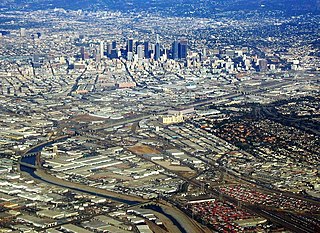
The Wholesale District or Warehouse District in Downtown Los Angeles, California, has no exact boundaries, but at present it lies along the BNSF and Union Pacific Railroad lines, which run parallel with Alameda Street and the Los Angeles River. Except for some ancillary commercial uses, its cityscape is mostly occupied by warehouses and refrigerated storage facilities. This area is known as Central City North in the Los Angeles city zoning map.

Mentryville was an oil drilling town in the Santa Susana Mountains in Los Angeles County, California, USA. It was started by Charles Alexander Mentry in the 1870s around the newly discovered oil reserves in that area. The first oil strike was on September 26, 1876. The town is located at the terminus of Pico Canyon Road, four miles west of the Lyons Avenue exit from I-5 in Santa Clarita. It is currently a part of Stevenson Ranch.

Board of Trade Building is a historic building in Downtown Los Angeles that was opened in 1929. Located at the northwest corner of Main Street and Seventh Street, the building was designed by Claud Beelman and Alexander Curlett in the Beaux Arts style with Classical Revival influence. The building was listed in the National Register of Historic Places in 2008 and is one of more than ten Claud Beelman buildings included in the National Register.
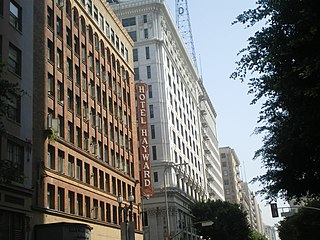
Spring Street in Los Angeles is one of the oldest streets in the city. Along Spring Street in Downtown Los Angeles, from just north of Fourth Street to just south of Seventh Street is the NRHP-listed Spring Street Financial District, nicknamed Wall Street of the West, lined with Beaux Arts buildings and currently experiencing gentrification. This section forms part of the Historic Core district of Downtown, together with portions of Hill, Broadway, Main and Los Angeles streets.
John Henry Bryant, known as J.H. Bryant, was a medical doctor in 19th century Los Angeles, California, a mining entrepreneur, and a member of that city's governing body, the Common Council, in 1888–89.

The California oil and gas industry has been a major industry for over a century. Oil production was a minor factor in the 19th century, with kerosene replacing whale oil and lubricants becoming essential to the machine age. Oil became a major California industry in the 20th century with the discovery on new fields around Los Angeles and the San Joaquin Valley, and the dramatic increase in demand for gasoline to fuel automobiles and trucks. In 1900 California pumped 4 million barrels (640,000 m3), nearly 5% of the national supply. Then came a series of major discoveries, and the state pumped 100 million bbl (16 million m3) in 1914, or 38% of the national supply. In 2012 California produced 197 million bbl (31 million m3) of crude oil, out of the total 2,375 million bbl (378 million m3) of oil produced in the U.S, representing 8.3% of national production. California drilling operations and oil production are concentrated primarily in Kern County, San Joaquin Valley and the Los Angeles basin.

The San Francisco Stock and Bond Exchange was a regional stock exchange based in San Francisco, California, United States. Founded in 1882, in 1928 the exchange purchased and began using the name San Francisco Stock Exchange, while the old San Francisco Stock Exchange was renamed the San Francisco Mining Exchange. The San Francisco Curb Exchange was absorbed by the San Francisco Stock Exchange in 1938. In 1956 the San Francisco Stock Exchange merged with the Los Angeles Oil Exchange to create the Pacific Coast Stock Exchange.

The historic Los Angeles Stock Exchange Building, also called the Pacific Stock Exchange Building, is located in the Spring Street Financial District within the Historic Core in Los Angeles. It was the headquarters of the Los Angeles Stock Exchange and the Pacific Stock Exchange from 1931 to 1986. It was then the site of two nightclubs.
The California Oil Exchange was a regional stock exchange in California. It opened in San Francisco on October 18, 1899, with a "large attendance" and 22 listed stocks. The stocks were from the oil districts of Los Angeles, Santa Barbara, and Fresno. Shares sold on the first day included St. Lawrence, San Joaquin, Northfield, Quitable, Big Panoche, Kings County, 100 Eagle, and 200 Stella. It was absorbed by the Los Angeles Stock Exchange in September 1900, when 51 members relinquished their membership in the California Oil Exchange in favor of membership in the other.
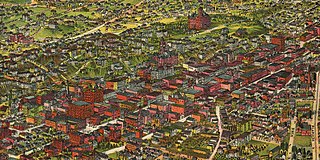
The late-Victorian-era Downtown of Los Angeles in 1880 was centered at the southern end of the Los Angeles Plaza area, and over the next two decades, it extended south and west along Main Street, Spring Street, and Broadway towards Third Street. Most of the 19th-century buildings no longer exist, surviving only in the Plaza area or south of Second Street. The rest were demolished to make way for the Civic Center district with City Hall, numerous courthouses, and other municipal, county, state and federal buildings, and Times Mirror Square. This article covers that area, between the Plaza, 3rd St., Los Angeles St., and Broadway, during the period 1880 through the period of demolition (1920s–1950s).













